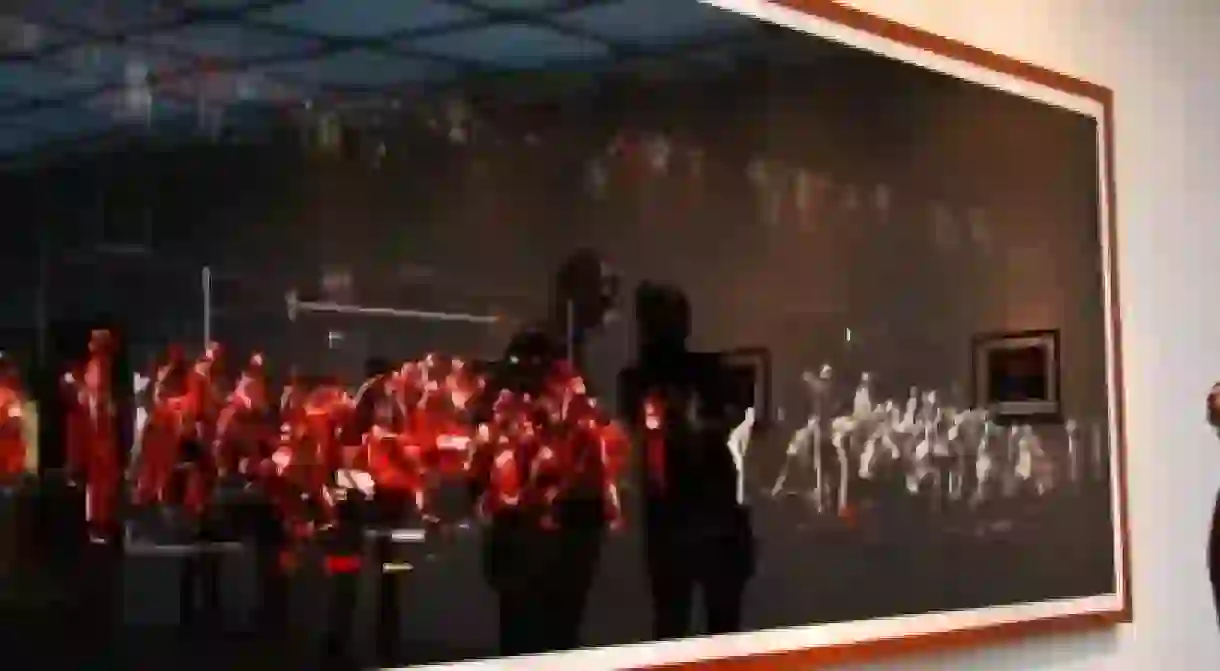Andreas Gursky | The World's Most Expensive Photographer

In 2011, Andreas Gursky earned himself the title of the ‘world’s most expensive photographer’ when his image Rhine II (1999) sold for $4.3 million in a Christie’s auction in New York. The record-breaking achievement came as a surprise to many, since the work featured a relatively bleak and deserted landscape without the vibrancy or boldness of the previous record-holder – Cindy Sherman’s 1981 piece Untitled #96 (1981), which sold for $3.89 million in May.
However, this was not Gursky’s first record-breaking photograph. In 2006 his 99 Cent II (1999-2009) reached $3.35 million, proving that his perspective – however ordinary and void of meaning an image may appear to be at first glance – is sending his work’s value steadily skywards and earning Gursky a reputation as one of the most influential photographers of our age.
Born in 1955 in what was then East Germany, Gursky’s relationship with photography seemed predestined. Both his father and grandfather were masters of the camera and, though he resisted for several years, the younger Gursky eventually followed suit. Rather than follow an entirely commercial path, however, Gursky saw an opportunity to enter the broader world of art.

Between 1978 and 1981 Gursky studied at the Folkwang University of the Arts, famously home to German photographer and founder of the avant-garde Fotoform group Otto Steinert. He then spent the next six years receiving training from Bernd and Hilla Becher at the Kunstakademie Düsseldorf. The influence of the Bechers on Gursky must not be underestimated, the duo worked collaboratively on projects that pushed the boundaries of photography to something on par with conceptual art in which they juxtaposed industrial images with images depicting their cultural function. The Becher school includes figures like Simone Nieweg, Thomas Ruff, Thomas Struth, Laurenz Berges, and Candida Höfer, all of whom took inspiration from the Becher’s documentary style critique.
This documentary style can be seen in what Gursky has referred to as ‘God’s-eye view’ – his unique style in which he takes panoramic shots that capture a whole scene in one image. We can see this particularly well in works like Tour de France (2007), which takes in a scene of the race in a beautiful mountain-scape, and Hong Kong Island (1994), which depicts a construction site amidst the innumerable skyscrapers that dominate the skyline. This technique not only creates truly epic images but also reminds viewers of the craft and sheer effort that goes into producing them. Gursky is no stranger to using helicopters, cranes and private rooftops in order to get that perfect shot.
Gursky embarks on such a painstaking process to create his images that he only produces a handful each year. Along with the research and technicalities that precede the work, Gursky embraces digital technologies and uses them to enhance and manipulate his photographs in post-production. For instance, the expanse of Paris, Montparnasse (1993) is created through the manipulation of multiple images placed alongside each other to give the impression of the block’s immensity. In this case, Gursky uses technology to exaggerate the presence of humans. In Rhine II (1999) he uses such technology to do the exact opposite: he removes all traces of people. The deserted horizon thus becomes something uncomfortably uncanny, the familiarity of the river itself juxtaposed with the haunting absence of the bustling evidence of life normally associated with the scene.

Gursky himself is a man of mystery, by and large refusing to comment upon his work. He prefers to let the images talk for themselves, which lends itself to the initial mystery of his work. The first-time viewer of his photography is seemingly presented with a stark representation of reality itself, his photos could be the view from windows of urban tower blocks or the floor of a factory production line—they do not seem to be ‘high’ art.

But what Gursky offers is not just a window, it’s a mirror in which we may see the world we live in from a higher perspective. What runs throughout Gursky’s work is the ambition to capture ‘the encyclopedia of life’. Fascinated with everything to do with the human species and our role in global culture, his photographs form a series of anthropological studies.
Whether capturing the essence of globalisation via the stacked shelves of 99 Cent II (1999-2009) or exploring what life would be in humanity’s absence like in Rhine II (1999), his work is so fascinating because it shows us ourselves from an angle we have never seen before. This ability is what makes Gursky one of the most influential artists of our time. When we consider this, the million-dollar price tag becomes easier to appreciate.
Want to see Andreas Gursky’s work? The Hayward Gallery in London have just reopened after a two-year refurbishment with a major retrospective of Gursky’s work. Read more about it here.













